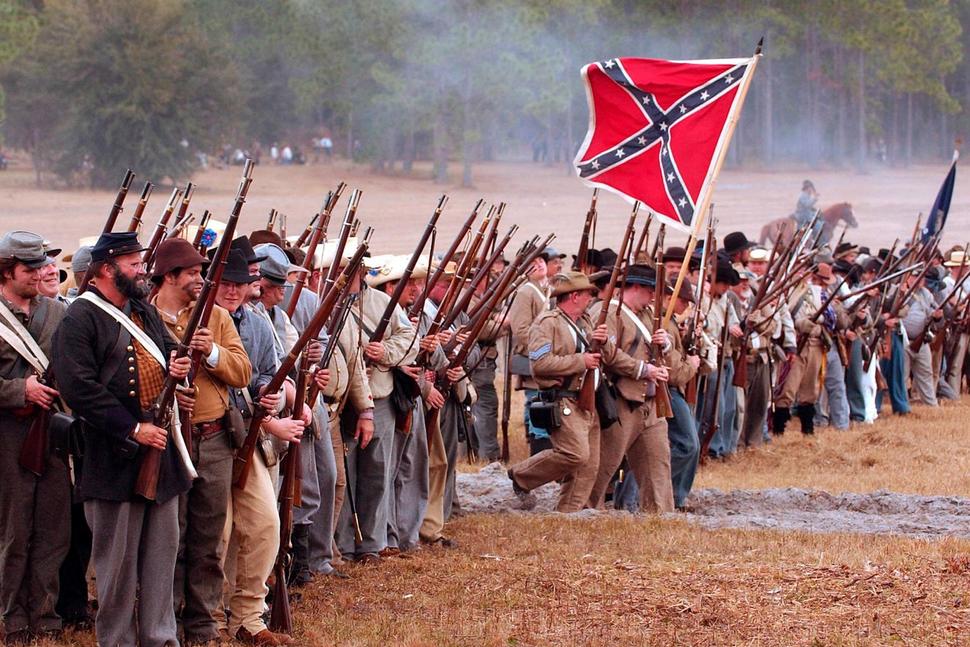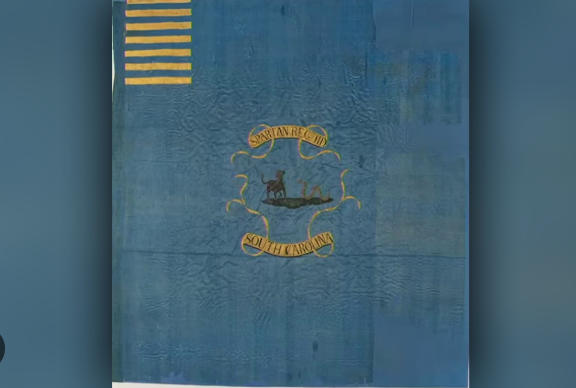Before showtime, pots and pans are some of the tools reenactor Tanya Haessly makes the most use of as a camp cook, feeding families and individuals taking part in a Civil War reenactment in Janney Furnace, Alabama.
Haessly and her kids sleep in a tent near the camp under the shadow of a Confederate flag — one of the many props used in the reenactment. Every morning, she builds up a fire to make breakfast and gets ready to welcome a new audience.
She told ABC News her job is to make sure history is told, and she wants her children to learn about what happened during the Civil War — especially when it comes to the Confederacy.
“Some people think that we’re racist for doing this,” she said. “I had people on the northern side. My mom was from Maine, my father was from the South. And so I had people on the northern side that died. I had people on the southern side that died.
“We’re just trying to portray history, and we have people of all races that fight for both sides because they did. So for me, this is history. I homeschool my children and this is a history lesson for them.”
Civil War battle reenactments have been taking place across the South since the 1960s. But reenactor Billy Pugh told ABC News that recently, they have been seeing a growing number of people interested.
“There were probably about three or four hundred spectators yesterday, so there were a good bit of people,” Pugh said. “They were lined up all the way around the road and up the hill to the flag yesterday.”
Some of these reenactors travel the country to tell the stories of their ancestors, and high school social studies teacher Jason Sumner expects to have a busy summer as the interest grows.
Sumner said the Civil War shaped the nation in many ways, and its ramifications can still be seen today. As an educator, he said the country doesn’t do enough with education to dig deep into the past, and he hopes people will remember the whole history behind the conflict.
“It’s so important that we don’t forget that and it is an offensive history, but it’s like I tell my students, it is well and good that history’s offensive because if it’s not, we will not develop that emotional connection to the past and we won’t learn from it,” Sumner told ABC News.
Along with his co-stars, Sumner will wear his uniform for six more performances in the spring alone. Depending on the battle, participants can portray Confederates one day, Union the next.
For Ron Carpenter, participating in the reenactment is not a hobby, but rather an homage to his ancestors who fought in the battles.
“If we don’t continue this, then my grandchildren and your grandchildren won’t have the option of learning exactly what happened, not the polished version, not the governmental version, but exactly what happened,” Carpenter said. “And that’s not fair to them.”
Pugh, whose son recently graduated school, said the version they show in the reenactments are not displayed in school, which gives him reason to continue spreading the history behind the Confederacy and his ancestors.
The importance of telling and sharing the Civil War history has grown over the past years since the rise of protests after the murder of George Floyd, according to the reenactors.
“When everything happened in 2020, I think what really pushed me to really want to go for the reenactments is to try to better help people understand the history,” Christopher Re, who has begun documenting the reenactments, said.
While they believe recent events have impacted the way people look back on the country’s racial history, many still resent seeing protesters tear down Civil War monuments.
“Not taking anything away from what happened in Minneapolis, I know that was a sad time, but I believe, you know, the monuments being removed and everything else was kind of like a spit in the face,” Re said.
Confederate monuments began being erected throughout the country shortly after the Civil War, but the majority took place around the 1900s during the Jim Crow era. Out of the 800 Confederate monuments and statues erected on public property across the country, 604 were dedicated before 1950 while 28 were built between 1950-1970 and 34 after 2000, according to the Southern Poverty Law Center’s research.
Since the protests took place, 73 Confederate monuments were removed or renamed from public spaces, according to the Southern Poverty Law Center, with more than 700 remaining across the country. For many, the monuments represent racism and white supremacy during the Civil War, and when the future of slavery was being decided.
Martin O’Toole is a spokesperson for the Georgia Division Sons of Confederate Veterans. The group is suing, in some cases, to stop cities across the country from removing Civil War monuments from public spaces.
He told ABC News it should be acceptable for people in the South to honor and celebrate the Confederacy.
“When we have calls for diversity, it should include diversity of opinion as well,” O’Toole said. “And if people say they don’t like statues, put up their own statues, let all Americans have their say [about] what they want about their ancestors, their history and the like.”
O’Toole said he has been seeing a growing interest in joining the organization over the past few years.
“There’s more passion because they feel like they’re under attack and so that we are being told that they’re the most singularly wicked and evil people that have ever lived on the planet,” O’Toole said.
While the group celebrates and honors the history of the Confederacy, others, like Richard Rose, Atlanta Chapter President of the National Association for the Advancement of Colored People, resent it due to its link to white supremacy.
Rose told ABC News, some people across the south are still fighting the Civil War since it ended more than 150 years ago.
“The bottom line is, obviously, the Civil War was fought on the premise that Blacks, in theory, are subservient to whites. And so every reenactment, every celebration continues to send that message,” Rose said.
He’s among Black leaders trying to remove the giant carvings of three Confederate generals at Stone Mountain in Atlanta.
“They should be completely covered and destroyed. They’re not works of art, and they are not historical,” Rose said.
But Abraham Mosley, the chairman at Stone Mountain, who is also African American, said the idea to destroy the carvings is a bad idea — and one very unlikely to happen.
“I have no problem with the carving. I have no problem at all,” Mosley told ABC News. “Removing that carving will not change people. The only thing that will change people is a change of heart.”
For Rose, monuments and reenactments honoring the confederacy are not a way to represent history.
“What country celebrates the failed insurrection against itself? And that’s what all of these … reenactments do,” Rose said.
But in the midst of the scalding sun in Alabama, in a field where rifles and cannons fire blank bullets and canisters for an audience, Haessly believes, regardless of the result of the war, it should be told.
“It’s still history. Win or lose, it’s still history. It’s still things that we need to remember,” she said.
–abcnews.go.com



